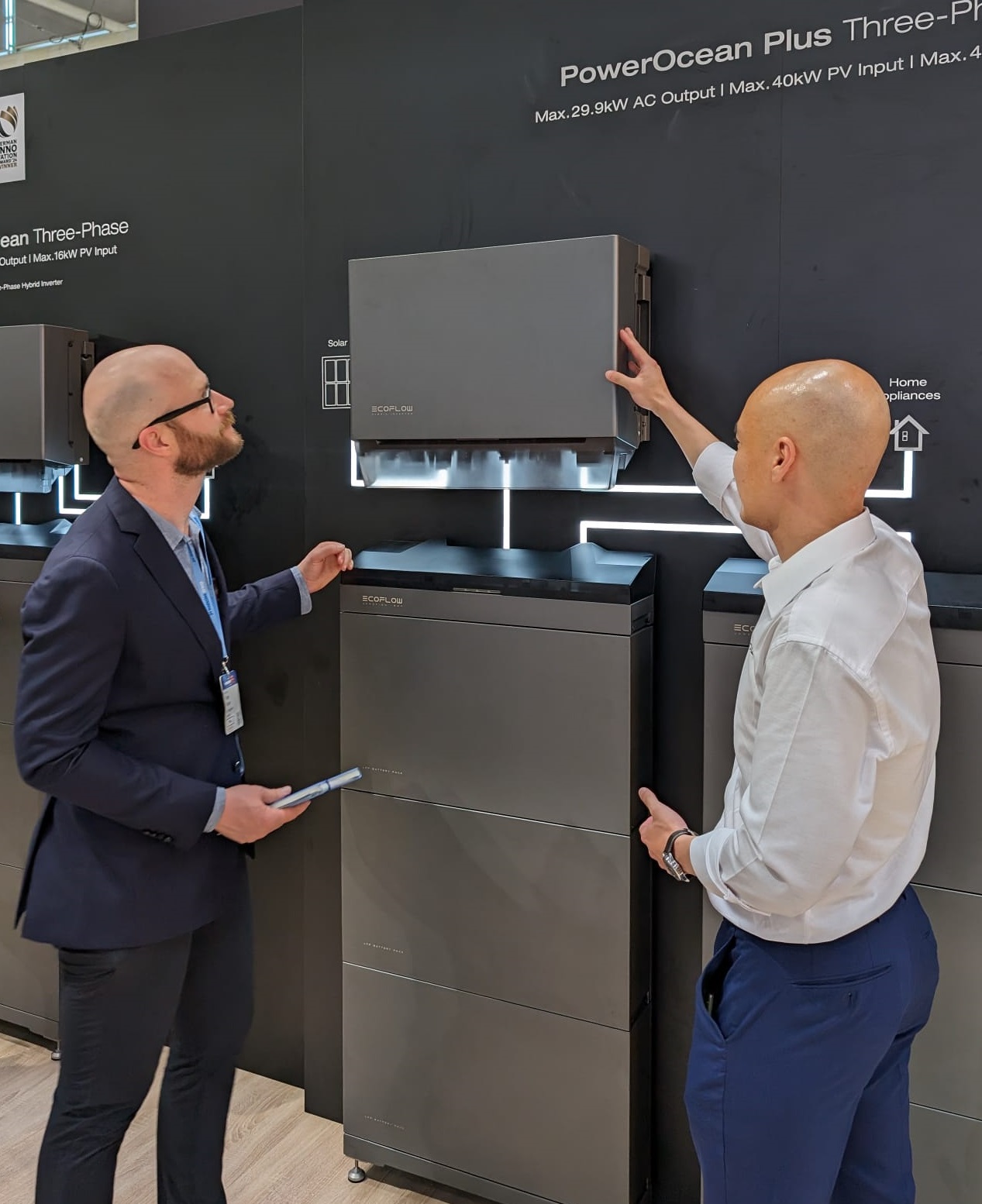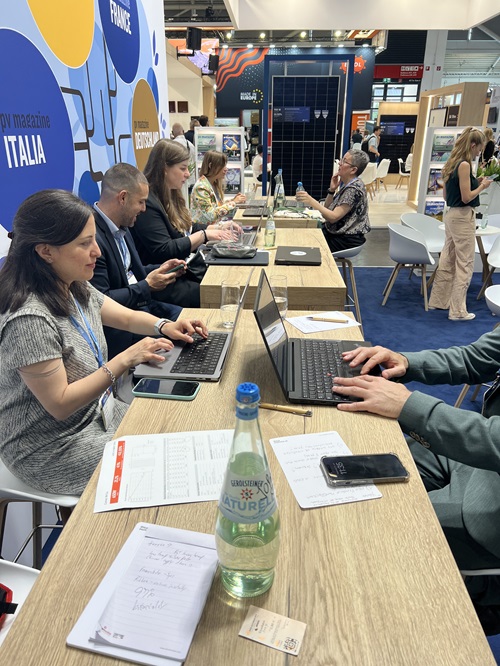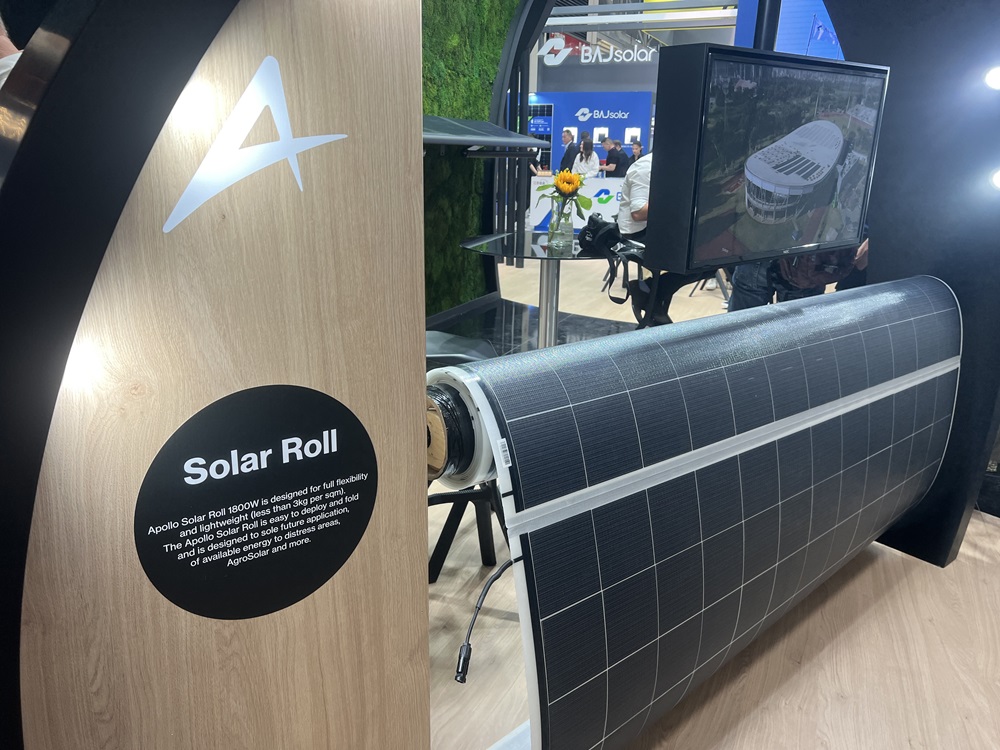GCL Perovskite, a branch of GCL Tech within the GCL Poly and GCL Solar group, introduced their latest perovskite and perovskite-silicon tandem solar modules. A key highlight was the public IEC test documentation, indicating they may have conquered the perovskite degradation challenge. The company plans to incorporate this technology in the top layer of their tandem modules, aiming for efficiencies above 27% in limited deployment testing next year.
The Solar Roll by Apollo, featured in the main image above, is a flexible roll measuring 20.1 feet in length and 6.6 feet in width. This innovative setup combines six 300-watt solar panels into a 1.8 kW array capable of generating more than 10 kWh in a single day. The unit, equipped with MC4 connectors, is designed for easy integration with any standard solar inverter.
Throughout the three days of Intersolar, as detailed on the pv magazine Intersolar Live Blog pages – Day 1, Day 2, and Day 3 – attendees witness an impressive array of battery products. Numerous manufacturers showcased their latest offerings, particularly focusing on home battery solutions.

EcoFlow’s latest release, the PowerOcean Plus, represents a significant increase in residential system size and capacity. This smart hybrid inverter can manage up to 40 kW solar input with a 29.9kW AC output. Notably, it can support up to 60 kWh of battery capacity, 15 kWh more than its predecessor. Kevin Benedict, EcoFlow’s product and solutions manager, explained that this upgrade was a direct response to customer demand for larger systems to optimize home solar use and EV charging.
The presence of electric vehicles and their charging infrastructure was also a focal point at the event.
The Evum-motor aCar, showcased with a solar panel cleaning robot strapped to its flatbed, is tailored for operations and maintenance tasks. Starting at €33,990, this versatile vehicle is offered in several configurations: the base model features a 16.5 kWh battery with a range of 91 km. Additional options include a 23 kWh battery, which extends the range to approximately 128 km for an additional €4,290, and a 33 kWh battery that offers up to 203 km for an additional €10,890. Available in six base packages, the aCar punches above its weight with a payload capacity of 1,100 kg and a towing capacity up to 1,500 kg.

The aCar’s design, including its 1.5 meter width, allows it to fit comfortably between the rows of panels on solar farms, enhancing its utility. Its low-speed torque is specifically advantageous for traversing loose and steep terrain, facilitating the transport of essential hardware and personnel to less accessible areas. The inclusion of the solar panel cleaning robot underscores the vehicle’s practical application in maintaining and operating remote or large-scale solar operations.
Electric bike charger econec shared three electric bike chargers: the eBike Box micro for home use, eBike Box mini C for businesses, (featured in the image below), and eBike Box Vision for public charging. A notable feature of these systems is their customizable charger. Representatives noted that the e-bike industry has around 25 charging standards, with the public charging model, the eBike Box Vision, accommodating up to five unique plugs. Although Bosch dominates the market with 50% to 60% of all charger adapters, it offers two different types of connectors. Currently focused primarily on the European market, Econec is actively seeking U.S. partners as it works to expand its certifications.

Image: John Fitzgerald Weaver, Commercial Solar Guy
Aiko is poised to launch the ABC Infinite Gen 3 solar module range, with efficiencies ranging from 24.2% to 25.2% in the fourth quarter. The standout 650 watt module, featuring 25.2% efficiency, aims to be the highest efficiency module globally upon its release. These products will be produced in the company’s two manufacturing facilities, with capacities of 10 GW and 14 GW of modules per year. A significant efficiency enhancement in these modules is the relocation of the busbars to the backside of the solar panels. While this adjustment reduces the bifaciality value to nearly 70%, it opens more silicon to face the sun on the front site, white significantly improving shade management capabilities.
Georg Giglinger, an environmental engineer, shared via Twitter what may have been the highest wattage module at Intersolar: Tongwei’s 765.18 watt rated, 24.63% efficiency panel.
Announced directly from the floor in Munich, Germany, Nextracker has acquired specialty ground screw manufacturer Ojjo in an all-cash transaction valued at approximately $119 million. Ojjo’s truss systems are designed to use half the steel of conventional foundations, aim to reduce grading requirements, and would be the foundation that supports NexTracker’s motors and torque tubes.
The pv magazine team at Intersolar Munich 2024 included over 30 representatives from regions such as Ireland, England, Western and Southern Germany, the U.S., among others.

This content is protected by copyright and may not be reused. If you want to cooperate with us and would like to reuse some of our content, please contact: editors@pv-magazine.com.








By submitting this form you agree to pv magazine using your data for the purposes of publishing your comment.
Your personal data will only be disclosed or otherwise transmitted to third parties for the purposes of spam filtering or if this is necessary for technical maintenance of the website. Any other transfer to third parties will not take place unless this is justified on the basis of applicable data protection regulations or if pv magazine is legally obliged to do so.
You may revoke this consent at any time with effect for the future, in which case your personal data will be deleted immediately. Otherwise, your data will be deleted if pv magazine has processed your request or the purpose of data storage is fulfilled.
Further information on data privacy can be found in our Data Protection Policy.